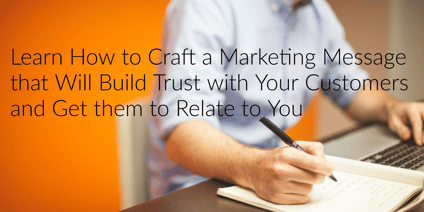“It’s one thing to be able to convince people and inspire them to do something but it’s quite another thing to actually inspire and inform them of the way that things really are and still have their loyalty and business.”
- Jonathan Baskin
When I heard this it resonated with every fiber of my being.
There are too many people that are wary of the promises that marketers make these days. Maybe you’re one of them, and you’re afraid to promote your brand.
This article will help you feel a little less afraid.
Bridging the Trust Gap
Good marketing is about providing your customers with value.
Your customers have a need, and what you have fulfills that need.
In a perfect world, everyone’s needs would be met seamlessly and without much deliberation as described in this book. However, because we are imperfect humans we have to rely on the tools we have to match ourselves to others’ needs.
"Advertising and brand building are out there ensuring that markets do not fall in the face of overwhelming information asymmetry" - Ahmad Zannad
Here’s what you need to do when communicating value to your customers:
- The most powerful way to inspire change is by telling a story. The only way to make lasting change last is, to tell the truth, and deliver on your promises.
- Don’t tell a story that exaggerates the truth or that is just clever. Your story needs to be connected to the value that you provide.
- Marketing is most powerful when it creates trust and builds brand loyalty.
- Customers vote with their dollars. You will know that your marketing is successful if they choose you and more importantly CONTINUE to choose you.
- Telling stories that are exaggerated or not true isn’t marketing— it’s deception. Customers hate this and they always figure it out.
- Your customers determine whether your marketing is successful by whether they choose to use your services
Carry a Good Service with Good Marketing
Everyone is a marketer. We all tell stories about ourselves in order to persuade and build relationships. A business works the same way. One of the primary functions of language is to persuade. Because we have such a powerful tool at our disposal, we must use this tool with great consideration and responsibility.
Marketing alone won’t make a product successful. Marketing is only one ingredient of a successful product.
Dishonest marketers take a bad product or service, slap a coat of hyperbole and smooth-talk on it, and expect these types of messages to carry their business. But businesses like these don’t last— they are eventually discovered.
Good marketing starts with making your product as good as possible. It starts with meeting the customer where they are at. When you understand their concerns, you can build a valuable solution that meets a need. Focus on this first.
Once you have done this that you can create an honest and persuasive message that will attract happy customers.
A successful message includes effective messaging and delivery.
- Don’t bombard customers with ads or emails
- Only send emails to people that have given permission
- NEVER use people’s personal information in ways that they haven’t consented to
- Be open and honest about the prices that you are offering
- Don’t use false urgency by making it look like something is a limited-time offer if it’s really not
- Only communicate with customers when you actually have something of value to offer (don’t just throw noise into the wind).

Conclusion: How to Take Action
As a marketer, I cringe when I see commercials or ads that are dishonest because trust is the most valuable result that you can achieve as a marketer.
Good marketing is the act of providing true value and building meaningful relationships that last with your customers.
People like to be persuaded and led by somebody like you if you offer great service and do so honestly.
Instead of being afraid of doing marketing, focus on building a relationship with your customers and creating a message that they’ll want to hear, and that builds trust.
To apply this at your next job, do the following:
- Do a walkthrough of the customer's home with them
- During the walkthrough ask them questions about the problems that they are experiencing
- Help identify materials and discuss the work that you do
- Connect this work to the value that you provide the customer
- If you do this right, you can upsell the customer on an additional service such as upholstery or leather at this point
- Provide good customer service
- Doing all of the above properly justifies charging a rate commensurate with the value of the service that you provided. This is an amount that you decide and that you can ask for with confidence.
- After you do a good job, ask your customer for their email address and permission to communicate with them periodically.
- Use this only for educational and promotional purposes periodically.
- Do not spam your customer
- Do not use your customer's email for other purposes without their permission or let other businesses use it.
- Get referrals from customers
- When you contact your referral you can let them know that you clean their friend's house in order to build credibility
As always, if you have any questions about what you've read or need advice on how to improve how your business markets, you can reach me at drew.crawford@aramsco.com
Enjoyed reading this post? Read the following articles:




